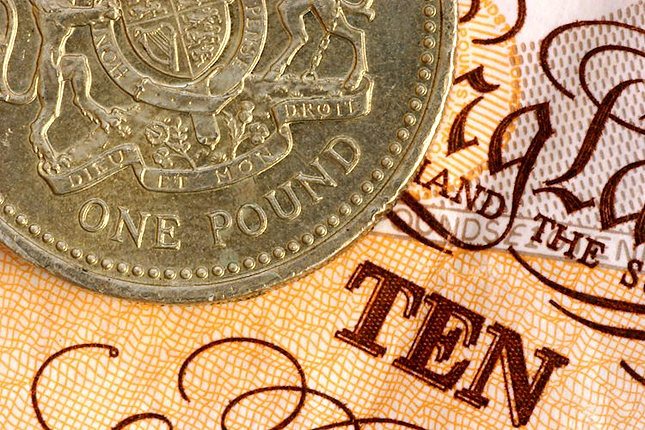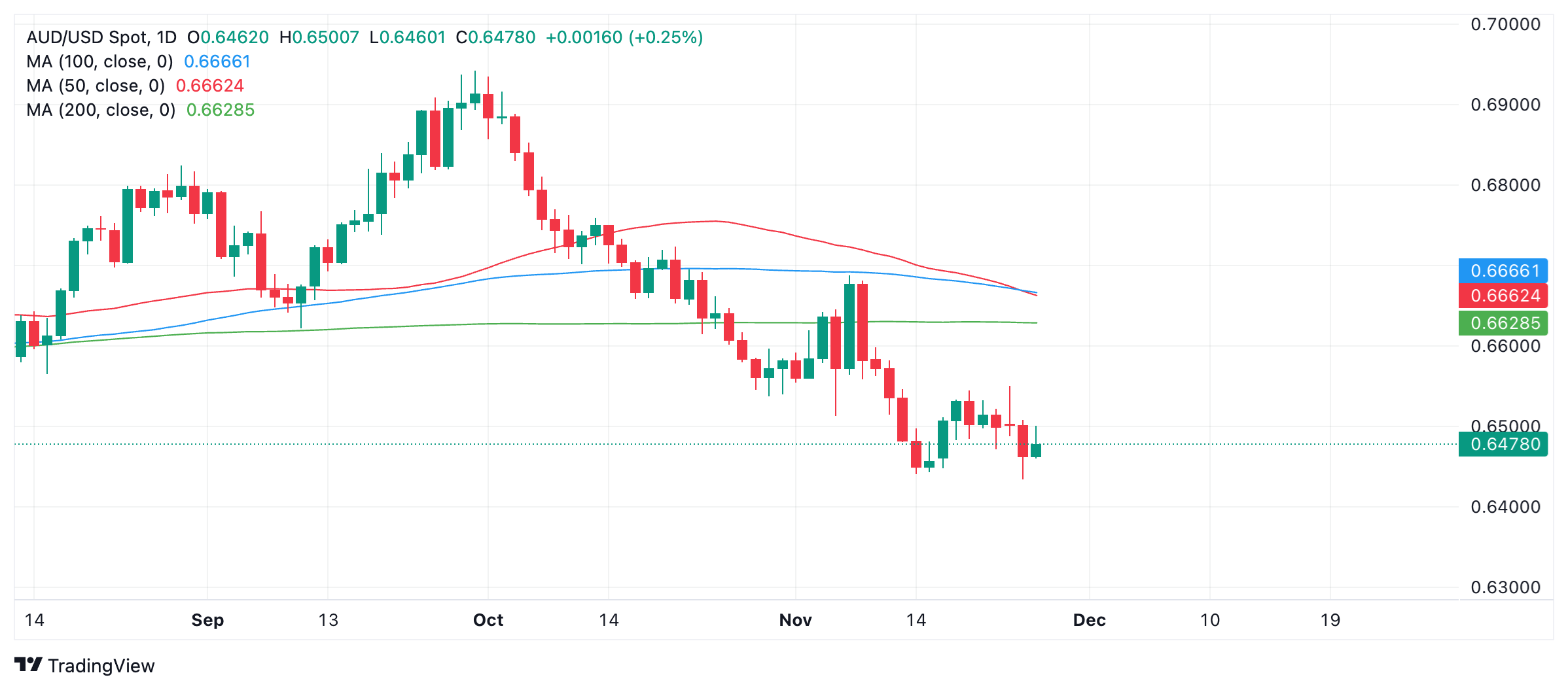- AUD/USD sees a brief up lift following higher trimmed mean CPI out of Australia in October.
- Figures showed headline CPI at multi-year lows but this was put down to lower energy and fuel prices.
- Further gains result from a slight increase in bets the Federal Reserve will cut rates in December.
AUD/USD bounces within a prolonged downtrend to trade in the 0.6870s on Wednesday after the release of Australian inflation data fails to change the widespread view that the Reserve Bank of Australia (RBA) will keep its “arms folded” at the next meeting, leaving its cash rate unchanged at a comparatively high 4.35%.
AUD/USD Daily Chart
The differential between central bank interest rates is a key driver of FX valuations, with central banks that have – or are expected to keep – interest rates relatively high compared to their peers seeing an appreciation in their country’s currencies.
AUD/USD is trading higher on Wednesday because unlike the RBA, the US Federal Reserve (Fed) is increasingly seen as likely to cut its key interest rate by 25 basis points (bps), or 0.25%, to a range of 4.50% – 4.75% at the Bank’s December policy meeting. Further, the US central bank has already cut by 75 bps this year whilst the RBA has not lowered rates at all.
The CME FedWatch tool calculates the probability of the Fed cutting by a quarter of a percentage point in December as 66.5% on Wednesday, up from the circa 56% at the beginning of the week.
Although still higher than the RBA rate, the greater likelihood of the Fed cutting is mildly supportive of the Australian Dollar (AUD) and AUD/USD.
AUD/USD’s downtrend since the beginning of October has been due to a radical change in market expectations about the trajectory of interest rates in the US. Prior to October these had been for the Fed to lower interest rates aggressively but robust US economic data led to a revision of these expectations. The outcome of the US Presidential election was a further factor supporting the pair.
Australian CPI data fails to encourage AUD
Data out overnight showed the Australian monthly Consumer Price Index (CPI) remained at 2.1% in October – the same as September – and lingering at three-year lows. This was below the 2.3% forecast by economists.
The Trimmed Mean CPI, however, rose by 3.5% in October from 3.2% in the previous month.
In addition, most of the weakness in price growth of the headline 2.1% figure was put down to falling energy prices due to the ongoing impact of the Energy Bill Relief Fund rebate. The data showed that energy prices as a subcomponent fell 35.6% in October. Lower global Oil prices also impacted headline inflation as petrol prices fell by 11.5%.
Since these factors are seen as transitory and not as representative of underlying inflation, the RBA is seen as unlikely to respond to them by lowering interest rates.
Although the headline CPI data failed to meet expectations the rise in trimmed mean CPI meant there was no change to the outlook for the RBA’s cash rate or the AUD.
Indeed, the RBA focuses more on the quarterly inflation figures, according to analysts at Brown Brothers Harriman (BBH) when it decides policy.
“It’s worth noting that the RBA focuses on the quarterly CPI prints because it’s less volatile and captures more items than the monthly CPI indicator. RBA cash rate futures continue to imply a first full 25bps rate cut to 4.10% in May (2025),” said Elias Haddad, Senior Markets Strategist at BBH.
The view was echoed by analysts at Societe Generale, who see no change in the cash rate at the RBA’s December meeting.
“The wait for lower rates in Australia continues and the RBA will sit on the fence until 2Q25 after another disappointing inflation print. Core CPI picked up to 3.5% YoY in October,” said Kenneth Broux, a senior FX strategist with the French lender.
Information on these pages contains forward-looking statements that involve risks and uncertainties. Markets and instruments profiled on this page are for informational purposes only and should not in any way come across as a recommendation to buy or sell in these assets. You should do your own thorough research before making any investment decisions. FXStreet does not in any way guarantee that this information is free from mistakes, errors, or material misstatements. It also does not guarantee that this information is of a timely nature. Investing in Open Markets involves a great deal of risk, including the loss of all or a portion of your investment, as well as emotional distress. All risks, losses and costs associated with investing, including total loss of principal, are your responsibility. The views and opinions expressed in this article are those of the authors and do not necessarily reflect the official policy or position of FXStreet nor its advertisers. The author will not be held responsible for information that is found at the end of links posted on this page.
If not otherwise explicitly mentioned in the body of the article, at the time of writing, the author has no position in any stock mentioned in this article and no business relationship with any company mentioned. The author has not received compensation for writing this article, other than from FXStreet.
FXStreet and the author do not provide personalized recommendations. The author makes no representations as to the accuracy, completeness, or suitability of this information. FXStreet and the author will not be liable for any errors, omissions or any losses, injuries or damages arising from this information and its display or use. Errors and omissions excepted.
The author and FXStreet are not registered investment advisors and nothing in this article is intended to be investment advice.
Recommended content
Editors’ Picks

EUR/USD retreats from tops post-US PCE, back near 1.0540
The bearish sentiment in the US Dollar remains in place and supports EUR/USD's constructive outlook, keeping it in the 1.0540 region after the release of US inflation data, as measured by the PCE, on Wednesday.

GBP/USD recedes to 1.2640 on US PCE data
GBP/USD remains positively oriented in the 1.2640 zone as the Greenback experiences a marked pullback following the PCE inflation release.

Gold remains sidelined near $2,640 following US inflation prints
Gold remains on the positive foot near $2,640 per troy ounce, as US inflation data matched initial estimates in October, while US yields display a negative performance across the curve.

The clock is ticking for France
A French political problem is turning into a problem for financial markets. The budget deficit in France is 6% of GDP, if the planned reforms are not enacted, then the deficit could rise to 7% of GDP next year. This is the level when bond vigilantes start to sniff around.

Eurozone PMI sounds the alarm about growth once more
The composite PMI dropped from 50 to 48.1, once more stressing growth concerns for the eurozone. Hard data has actually come in better than expected recently – so ahead of the December meeting, the ECB has to figure out whether this is the PMI crying wolf or whether it should take this signal seriously. We think it’s the latter.

Best Forex Brokers with Low Spreads
VERIFIED Low spreads are crucial for reducing trading costs. Explore top Forex brokers offering competitive spreads and high leverage. Compare options for EUR/USD, GBP/USD, USD/JPY, and Gold.

-638683085962702896.png)